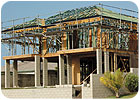
Q: All building codes have adopted some form of energy code. The UBC, for instance, adopted the Model Energy Code, which goes with ASHRAE/IS 90.1 for commercial buildings. A key point is that the UBC requires that a major renovation of a building include full code upgrades. This would include energy conservation by means of proper roof insulation. The ceiling alone could be insulated and air proofed, which would put the designer back into the dry-pipe option. I think that if the roof is insulated, wet pipe would suffice. This can compensate the cost (compared to dry-pipe), comply with the energy code and give energy savings over the life of the building. Compliance with energy codes should be a consideration in the project. In fact, the authority should probably demand such upgrades. If so, the fire protection could be kept as wet. Wouldn’t you agree?
A: What we see most often in the northern states, in terms of insulation, is that the suspended ceiling will get the lion’s share, in order to minimize heating bills. As usual, the engineering decisions are economically driven. In this case, I don’t think the AHJ in question gave any consideration to energy code compliance whatsoever.

A: A while back, I received some flak from a manufacturer of tamper switches for my remarks regarding the tamper switch on the dry valve trim. Frankly, I was unaware of the NFPA 72 requirements. Here in Chicagoland, this is something that just doesn’t happen (on the dry valve trim). At any rate, the manufacturer forwarded a load of documentation (including various code requirements) for my information and future reference.
Q: I have a concern about a current project-an existing school building that has been added onto several times in the past 70 years. Currently, we are adding three new additions (north, south, west) onto the building. We are providing sprinklers in the areas that are being added or remodeled. The original part of the building is not having sprinklers installed. A two-hour fire separation is provided between the new additions and the original building. Because of the size and configuration of the building, two separate fire services were brought into the additions on the north and the south. To serve the 2,000-sq.-ft. locker room addition on the west, we propose to route the sprinkler piping through the corridor and gym of the existing building between the addition on the north and the addition on the west.
A question has been raised as to the acceptability of this pipe routing with regards to NFPA 13 (1999). The only reference that I can find in NFPA 13 is in Appendix A, Paragraph A-5.1. However, I do not feel that this applies for two reasons: first, the original building is not of combustible construction; and second, the locker room addition on the west is small enough that it could be served off a limited area sprinkler system, as permitted by BOCA. In that case, there would be no alarm devices. Also, there is additional assurance of obtaining adequate water flow from a dedicated sprinkler system.
I anticipate that the school board will have to do something in the very near future to the remainder of the building that was not remodeled because the additions/remodels were air-conditioned. The original part of the building is not air-conditioned. When that occurs, I would expect to put sprinklers in the remainder of the building as part of that project. I would greatly appreciate any input that you could offer on this matter.
A: Schools as well as hospitals are notorious for these kinds of “one-at-a-time” add-ons to original buildings. And the reason for this can be found by investigating how funds for their construction projects are budgeted. What you are proposing is sound. It makes perfect sense to route the piping for the locker rooms from the new sprinkler system piping. Some insurance companies ask for all sprinkler piping to be routed through sprinklered areas; in that case, you would be asking for sprinklers in each room that the new (naked) feed pipe is to pass through-specifically, the gym and the corridor. This is not an extraordinary addition in terms of cost, and may be a good idea in lieu of the fact that gymnasiums also are large assembly areas at times throughout the year.
What you wind up with is a partially sprinklered building that (hopefully) will be completely sprinklered at some future date, as available school funds dictate.
What I would also do, if feasible, is to interconnect the FDC supply piping in such a fashion that a single fire deptartment connection, located on the street side of the school, could service both systems. The sprinkler riser rooms should have exterior access, and some thought should be given to perhaps sprinklering some of the existing areas, such as the stage, library stack room, shop and/or paint storage areas.
Q: A 3,000-gpm fire pump was installed to provide protection to an industrial facility with controlled access (the facility is located in a military depot). The section on fire pumps in the construction specifications calls for the fire pump installation to comply with NFPA 20. However, in another section of the specifications, pipes, valves and fittings are specified to meet AWWA standards. As a result, the contractor installed a UL-listed fire pump and controller, but installed piping, valves and fittings per AWWA standards. Pipes and fittings are carbon steel per ASTM A53, which meets NFPA 20. The valves (non-rising stem), however, are provided per AWWA Standards. The installation is about three years old.
Realizing that NFPA 20 requires valves to be the O, S and Y type and listed for fire protection service, is it a must to replace the AWWA-rated valves that have been installed with UL-listed, O, S and Y type in order to meet NFPA 20? That the valves are not O, S and Y does not appear to be an issue since the valves are locked open, and the pump house itself is normally locked and can be accessed by authorized personnel only. I guess the issue here really is whether the AWWA-rated valves are functionally equivalent to valves that are UL listed for fire protection service. Your comments would be highly appreciated.
A: It’s a standard requirement of both NFPA 13 and 20 that all system control valves be of the indicating type. Many authorities accept indicating butterfly valves in the fire pump and bypass assembly. Ordinarily, an insurance company or municipal fire prevention bureau would call for the replacement of the AWWA-approved, non-rising stem valves in this instance. However, since the valves are locked in the open position, it does seem hard to distinguish what the fuss is about. Requiring the outside stem and yoke valves is just seen as standard, good safety practice for fire protection systems. In your case, it all depends on the attitude of the AHJ.
Q: We’ve been asked by one of our clients about providing sprinkler protection in an accessible trench for their press operations. The press equipment is punching out large sheets for use in the manufacture of residential laundry equipment. Is there design criteria covering this type of installation? We have not been able to find anything in NFPA yet-although that doesn’t mean it’s not there! There is a horizontal conveyor in the trench for material handling. The trench is approximately 50' long. Any assistance will be greatly appreciated.
A: I don’t know of anything in the NFPA codes that specifically covers this application. However, this particular risk represents a definite life-safety hazard-not only because the frequency of fires is higher in such a case, but also that these fires grow very quickly in proportion to the amount of grease and oil in this location. I would recommend a deluge system for this press, one that covers both the equipment and the accessible trench. The system should be tripped by some type of detection system, and also one or two manual trips. A high density is required (.30 gpm/sq.-ft. or higher), which may or may not necessitate a booster pump. Another good idea is to provide a hand-hose station close to this vicinity.